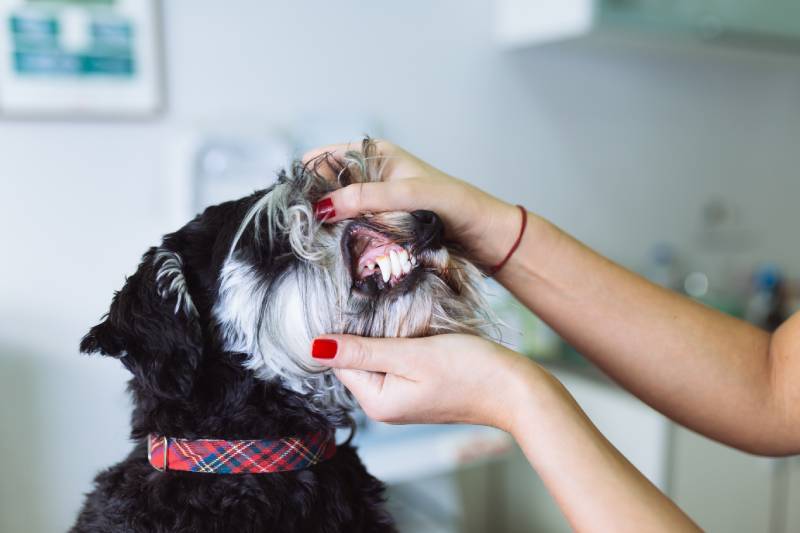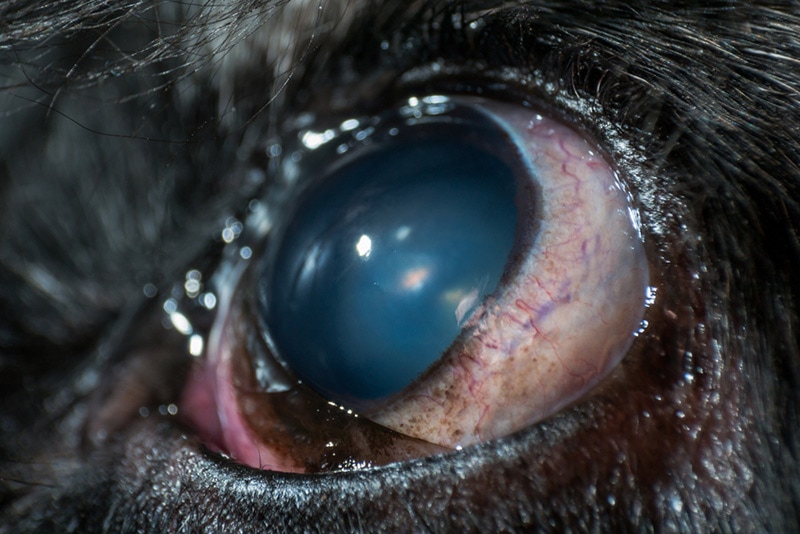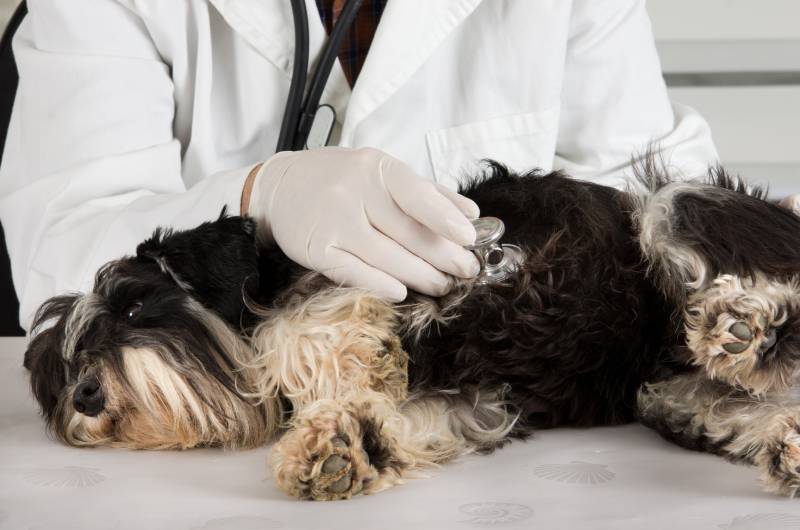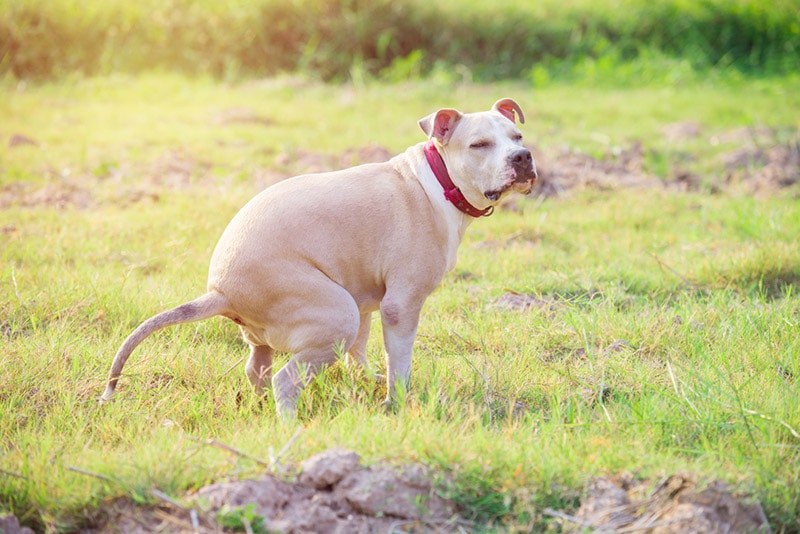11 Miniature Schnauzer Health Problems to Watch Out For
Updated on

Miniature Schnauzers are a very friendly, lively, and loveable breed that will bring their owners plenty of joy. This breed is among the most popular in the world thanks to its dashing good looks and incredible charm. As with any purebred dog, though, they are predisposed to some genetic health conditions.
Owning any dog comes with great responsibility, and you must understand the potential health problems your beloved pet could face. Here we are going to go over the most common health conditions of the Miniature Schnauzer so that you can understand more about them and work alongside your veterinarian to keep them as happy and healthy as possible.
The 11 Common Health Problems in Miniature Schnauzers
1. Obesity
- Weight gain
- Excess body fat
- Inability or unwillingness to exercise
- High body condition score
Obesity is by definition, an accumulation of excess body fat. Since body fat and weight generally go hand in hand, using body weight to assess whether a dog is overweight or obese is much easier than attempting to measure the overall body fat.
Dogs are considered to be obese when they weigh more than 20% or above their ideal body weight. Since it can lead to a slew of other health conditions, it’s important to get a hold of obesity as soon as possible.

Causes
Obesity is caused when a dog eats more calories than they expend. This is typically related to diet and/or lack of exercise. Obesity is more common in senior dogs due to their decrease in activity or even arthritis or other health-related conditions but can happen at any age.
Diagnosis
Obesity may be diagnosed with a physical examination. The veterinarian will chart the dog’s weight and possibly obtain the body condition score, which will evaluate the amount of body fat.
Treatment
Obesity is treated through diet and exercise. Depending on how obese the dog is, the increase in exercise may be done gradually. Owners will be discouraged from overfeeding, offering any table scraps, and feeding too many treats. The veterinarian will advise the best way to go about this and may even suggest a certain food that may aid in weight loss.
2. Dental Disease
- Bleeding or inflamed gums
- Discolored teeth (brown or yellow)
- Loose or missing teeth
- Bad breath (halitosis)
Dental disease is a very common condition that affects over 80% of dogs over 3 years of age. Periodontal disease is the most common form of dental disease in dogs and will affect not only the teeth but also the gum and bone. Miniature Schnauzers and other small breeds are especially predisposed to dental disease.

Causes
The mouth has a lot of bacteria, which can multiply on the tooth surface, eventually leading to the formation of plaque, which is a collection of bacteria. Some plaque may be removed by normal habits such as chewing, but when the plaque remains on the teeth it will thicken and mineralize, leading to tartar.
Tartar is a rough material and will allow even more plaque to stick to the surface of the teeth. If left untreated it will come in contact with the gums and lead to inflammation, known as gingivitis, which is the first stage of periodontal disease.
Diagnosis
A veterinarian will check your dog’s teeth during a routine exam. If dental disease is suspected, diagnosis can be done by putting the dog under anesthesia and doing a more thorough examination of the mouth, which may include X-rays to assess the roots and surrounding bone.
Treatment
The treatment for dental disease will depend on the severity of the condition. Stage 1 periodontal disease may not require any further treatment and owners may just be advised to brush their dog’s teeth daily.
If the disease has progressed to stage 2 or beyond, a dental cleaning will be performed under general anesthesia. Plaque and tartar will be removed, and the teeth will be polished during the procedure. This may require more advanced restorative procedures and may result in the need for tooth extraction in the most severe cases.
3. Allergies
- Itchy skin
- Excessive scratching
- Excessive licking
- Face rubbing
- Redness of the skin
- Fur loss
- Recurrent skin and ear infections
- Gastrointestinal issues
Allergies are very common in dogs and are one of the main reasons for visits to the veterinarian. They occur when the immune system reacts to a foreign substance. Dogs can suffer from flea allergies, environmental or seasonal allergies, or food allergies.

Causes
Allergic reactions can be caused by a wide variety of substances. Environmental or seasonal allergies can be caused by grasses, pollen, mold, dust mites, cigarette smoke, feathers, chemicals, pests, medicines, and more. Flea saliva is believed to be the allergen that results in a flea allergy and can be triggered by only one bite. Food allergies are most often related to protein sources, especially dairy, beef, chicken, chicken eggs, soy, or wheat gluten but can also be related to other ingredients.
Diagnosis
Diagnosing allergies is typically done through a thorough physical examination and a close look into the dog’s medical history. Allergy testing for dogs is only done to diagnose seasonal or environmental allergens and can be performed via an intradermal skin test or a blood test. Skin testing is the most accurate of the two and is typically performed by board-certified veterinary dermatologists.
Treatment
Treatment for allergies will largely depend on the root cause. Food allergies are often treated using an elimination diet to discover which food is the culprit and then remove it from the diet. This may even include a prescription diet, depending on your veterinarian’s recommendation.
Treating environmental or seasonal allergies will focus on reducing or eliminating the associated symptoms through several routes including oral medication, injectable medication, steroids, or even supplemental fatty acids. Frequent baths can also help remove potential allergens and provide relief to the skin.
Flea allergies are managed by keeping up on regular flea and tick preventive medication. This is either done orally or topically and your veterinarian can discuss with you the best current medication on the market.
4. Eye Problems
- Cloudy appearance of the eye
- Watery or colored discharge
- Dilated pupils
- Your dog is bumping into objects
- Hesitation in new places
- Unwillingness to go up and down stairs
- Irritation of the eye
- Eyes are red, puffy, or swollen
- Pawing at the face
- Red swollen lump in the corner of the eye (Cherry Eye)
Miniature Schnauzers are prone to suffering from eye problems, especially later in life. This includes conditions like cataracts, cherry eye, eye ulcers, and glaucoma. These conditions may be inherited or developed but will require prompt treatment from a veterinary professional. Signs of eye problems are largely dependent on the specific condition.

Causes
Cataracts are more common in senior dogs, but they can also be triggered by inadequate nutrition, infection, diabetes, or even injury to the eye. Cherry eye occurs when the small ligament that holds the third eyelid gland in place either stretches or breaks. Eye ulcers often result from trauma or a foreign body entering the eye, and glaucoma results from inadequate drainage of aqueous fluid that can be brought on by a variety of other issues.
Diagnosis
A veterinarian will go over the dog’s medical history and perform a thorough examination of the eyes using a light. They may measure the pressure within the eye using an instrument called a tonometer if glaucoma is suspected. A simple fluorescein stain test is used to diagnose a suspected corneal ulcer.
Treatment
Treatment of eye problems will depend on the condition the dog is suffering from and any underlying conditions that could have caused the issue to arise. Treatments may consist of antibiotic drops, drops for pain or inflammation, artificial tears to help with dryness, and oral medications. In some cases, surgery may be necessary. The veterinarian will go over treatment once a proper diagnosis is established.
5. Diabetes
- Increased thirst
- Increased urination
- Increased appetite
- Weight loss
- Lethargy
- Dehydration
- Cataracts
Diabetes, known scientifically as diabetes mellitus is a disease of the endocrine system. It occurs when blood sugar can no longer be effectively regulated by the body resulting in either a lack of insulin or an inadequate biological response to insulin within the dog’s body.

There are two different types of diabetes, Type I and Type II.
Type I – With type 1 diabetes, the dog will be fully insulin dependent because the body can no longer produce or release enough insulin into the body.
Type II – With type II diabetes, the dog will not be insulin-dependent. In this case, the body can produce insulin, but the organs and other tissues have become resistant to the insulin and do not respond properly.
Causes
Diabetes can result from several different causes including obesity, genetics, increased hormone levels, Cushing’s disease, other endocrine disorders, or even chronic or repeated pancreatitis which results in extensive damage to the pancreas.
Diagnosis
Veterinarians may suspect diabetes if a dog is exhibiting any of the above signs of the condition. To officially diagnose the condition, they must find persistent high blood and urine glucose values through urinalysis and blood testing.
Treatment
Diabetes treatment will depend on whether the dog is suffering from Type I or Type II. Treatment typically involves a special diet, a good exercise regimen, and daily insulin injections. The treatment plan will be based on the individual after a proper diagnosis has been completed.
6. Portosystemic Liver Shunts
- Poor growth (congenital)
- Poor appetite
- Weight loss
- Increased thirst
- Increased urination
- Difficulty urinating or blood in the urine
- Vomiting, which may contain blood
- Diarrhea, which may contain blood
- Behavioral changes
Liver shunts occur when the blood supply that should go to the liver from the abdominal organs goes to the systemic circulation instead. This results in the liver being unable to effectively remove toxins from the bloodstream.

Causes
Congenital shunts are the most common and are responsible for approximately 80% of cases. Dogs are usually less than 3 years of age when they begin showing signs of the condition. Genetic predisposition is recognized in certain dog breeds and highly suspected in others.
Diagnosis
Blood tests that check liver function will be performed to diagnose liver shunts. An ultrasound of the liver may be warranted.
Treatment
Around one-third of dogs with liver shunts can be successfully managed with dietary changes and medication. More severe cases may require surgery by a board certified specialist surgeon to properly treat the condition.
7. Pancreatitis
- Severe lethargy
- Abdominal pain
- Persistent vomiting
- Severe dehydration
- Collapse and shock
The pancreas plays an important role in the process of digestion because it produces enzymes that break down sugars, fats, and starches. Pancreatitis is an inflammatory reaction within the pancreas due to an inappropriate, early activation of an enzyme within the organ that causes it to begin digesting itself.

Causes
Over 90% of the time, the cause of pancreatitis in dogs cannot be determined. Certain breeds like Miniature Schnauzers are more likely to develop pancreatitis due to their tendency to have high blood triglyceride levels. Dogs taking certain medications may also be more likely to develop the condition.
Diagnosis
There are pancreatic-specific blood tests that can be performed if a veterinarian suspects pancreatitis. These special tests are not always accurate so the best way to diagnose the condition is via abdominal ultrasound. This can be an issue too, as the tissue of the pancreas must be abnormal enough to visualize during the ultrasound and this most often occurs in dogs with acute and severe pancreatitis.
Treatment
Treatment for pancreatitis involves supportive care regardless of whether the condition is acute or chronic. Severe cases are typically critical and will likely require hospitalization and care in a 24-hour veterinary facility. Mild to moderate cases may require shorter hospitalization to aid with dehydration.
- IV fluid and electrolyte support
- Nutritional support
- Pain medication
- Anti-nausea medication
- Stomach protectant medications
- Antibiotics
8. Bleeding Disorders
- Dilated pupils
- Abnormally reflective eyes
- Nervousness at night
- Reluctance to enter dark areas
- Bumping into objects
- Cataract formation
There are several types of inherited bleeding disorders that can occur in dogs. These disorders range in severity from very mild to severe and may go unnoticed until either an injury occurs or a surgical procedure is performed. Miniature Schnauzers are particularly prone to some rare diseases of the blood including Hemolytic Anemia and Thrombocytopenia.

Causes
Most often, bleeding disorders are the result of a genetically inherited deficiency in specific proteins necessary for blood to clot.
Diagnosis
If a bleeding disorder is suspected, the veterinarian will do blood testing to confirm the diagnosis. This can include a complete blood count, chemical blood profile, and diagnostic testing for blood clotting.
Treatment
Corticosteroids or other immunosuppressive drugs are typical treatments for autoimmune bleeding disorders, to slow and stop the immune system from destroying the cells. Blood transfusions may be necessary for anemic dogs.
9. Heart Disease
- Persistent cough
- Difficulty breathing
- Fatigue
- Inability to exercise
- Change in behavior
- Fainting or collapse
Heart disease is a blanket term for many different conditions related to heart function. Heart failure is the leading cause of death among Miniature Schnauzers in their senior years.
The breed is predisposed to sick sinus syndrome, which is a dysfunction of the sinus node which is a part of the body’s electrical system that signals the heart to beat, and also a condition called Patent Ductus Arteriosus, which occurs when a small vessel that carries blood between two parts of the heart fails to close shortly after birth as it would normally. This results in too much blood being carried to the lungs, which leads to fluid build-up and strain on the heart.

Causes
Since heart disease is a blanket term, there can be different causes. Most cases of heart disease in dogs are caused by the weakening of a valve. A heart valve can slowly deform leaving it unable to close tightly causing blood to then leak back around this valve and put a strain on the heart. Pets with heart valve disease also referred to as mitral valve disease may have a heart murmur.
Diagnosis
Diagnosis of heart disease can be done using several diagnostic procedures including X-rays, electrocardiogram, echocardiogram, cardiac catheterization, or blood and urine testing.
Treatment
Prescription medications are the primary treatment for heart disease. Other forms of treatment may include dietary modification, weight loss, and possibly surgery depending on the severity and type of the heart condition.
10. Cushing’s Disease
- Increased appetite
- Excessive thirst or drinking
- Thinning of the skin
- Recurrent skin infections
- Hair loss
- Frequent urination
- Muscle weakness
- Enlarged abdomen
- Panting
- Lethargy
Cushing’s disease (hyperadrenocorticism) occurs when the adrenal glands overproduce cortisol (cortisone) in the body. Excess cortisol puts dogs at risk of several serious conditions such as diabetes and kidney damage, which can be life-threatening.

Causes
There are three different types of Cushing’s disease, all of which have different causes:
Pituitary-Dependent Cushing’s Disease
Pituitary-dependent Cushing’s disease occurs when a tumor of the pituitary gland secretes too much of the hormone that stimulates the production of cortisol. These tumors are often small and benign but in 15% to 20% of cases, neurological signs may develop as it grows. The pituitary tumors are responsible for the majority of Cushing’s disease cases.
Adrenal Gland Tumor
A tumor of the adrenal glands can lead to Cushing’s disease since the adrenals create stress hormones. An adrenal gland tumor will either be benign or malignant and make up approximately 15% to 20% of cases.
Iatrogenic Cushing’s Disease
Iatrogenic Cushing’s disease in dogs is caused by excessive or long-term steroid use.
Diagnosis
Veterinarians will often use blood and urine tests to diagnose Cushing’s disease. Ultrasounds may also be used to help detect a tumor on an adrenal gland and to rule out any other diseases that could be causing similar signs. MRI is also a very effective way to diagnose Cushing’s since it allows for a thorough assessment of the adrenal glands.
Treatment
Treatment of Cushing’s disease in dogs is largely dependent on the underlying cause. Treatment options may include surgery, medication, and radiation. If the cause of Cushing’s is due to excessive steroid use, the dosage of steroids should be reduced and discontinued under the supervision of a veterinarian.
11. Bladder or Kidney Stones
- Straining to urinate
- Bloody or discolored urine
- Pungent urine
- Frequent urination
- Accidents in the house
- Increased licking of the genital area
- Lethargy
- Weakness
- Reduced appetite
- Vomiting
Dogs can develop stones anywhere in the urinary tract and these stones can come in different shapes and sizes. They are the result of the hardened accumulation of minerals in the urine including struvite, calcium oxalate, and urate.

Causes
Any dog can be affected by urinary stones, but Miniature Schnauzers have a genetic predisposition to forming stones. Calcium oxalate stones are most often observed in males and dogs of middle-aged and older. Struvite, or magnesium ammonium phosphate stones, are most often seen in females.
In addition to genetic predisposition, stones can also result from urinary tract infections, the type of food they are eating, supplements, and certain metabolic diseases.
Diagnosis
Most urinary stones in dogs can be diagnosed through an X-ray or abdominal ultrasound. The veterinarian will likely collect urine for a urinalysis.
Treatment
Treatment will depend on the severity of the condition. If there is no blockage present, dogs may be put on a special prescription diet and/or medication to help dissolve the stones. Some stones may not dissolve and could require surgical removal. If the dog has a blockage present, emergency surgery is needed.
The 4 Tips for a Healthy Miniature Schnauzer
1. Choose a Reputable Breeder
If you are purchasing a Miniature Schnauzer puppy, you need to ensure you are using a reputable breeder. Reputable breeders will focus on the health of their dogs and the betterment of the breed as a whole. They will perform necessary health checks and DNA testing to ensure both parents have a clean bill of health and are free of genetic conditions before breeding.
Do your research and make sure they are affiliated with your national breed club, provide veterinary records and registration papers, and allow you to visit the premises and meet the parents. This is extremely important for any purebred puppy, but especially a breed with so many genetic health concerns.

2. Feed a Well-Balanced Diet
Nutrition is a vital part of any dog’s health. Your Miniature Schnauzer requires a high-quality, well-balanced diet that is appropriate to their age, size, and activity level. Thoroughly research the food you are using to ensure they are getting the best quality possible. Take measures to prevent obesity by feeding proper portions, avoiding table scraps and other human foods, and being mindful of how many treats you give.
3. Make Sure They Get Adequate Exercise
A Miniature Schnauzer will require about 60 minutes of daily exercise to keep up with their physical needs. They have fairly high energy levels and this will allow them to expend that pent-up energy. Three to four short walks per day or even a blend of walks and playtime are great ways to get this exercise in.
- Related Read: How Much Exercise Does a Miniature Schnauzer Need?

4. Keep Up With Wellness Exams
Keeping up with regular health examinations is an important part of keeping your Miniature Schnauzer as healthy as possible. This allows your veterinarian to assess your dog’s overall health and well-being and recognize anything out of the ordinary. This also allows you to keep up with preventative medication and gives you a chance to ask any questions you have regarding your dog’s health.
Final Thoughts
As a breed, the Miniature Schnauzer is predisposed to several health problems that owners should always be on the watch for. There are plenty of steps you can take to ensure your pup remains as healthy as possible. Remember that anytime your dog shows any unusual signs, it’s time to get in contact with your veterinarian to rule out any medical issues.
Featured Image Credit: Debra Anderson, Shutterstock












